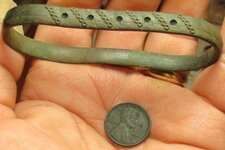cambria09
Bronze Member
- Jun 10, 2012
- 1,838
- 3,840
- Detector(s) used
- Mine Lab Sovereign Elite, Mine Lab Etrac, Garrett ATMax
- Primary Interest:
- All Treasure Hunting
Hello All. I found this at 1900's site near an old sawmill. It is brass and looks like it was used to bind something together...any ideas out there are appreciated. Thanks for tuning in.
C9
C9












